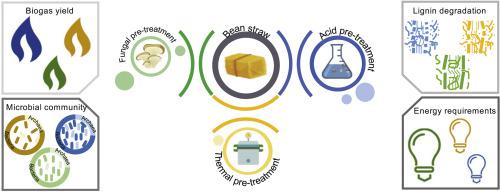Biomass & Bioenergy ( IF 6 ) Pub Date : 2020-10-01 , DOI: 10.1016/j.biombioe.2020.105775 J.J. Montoya-Rosales , M. Peces , L.M. González-Rodríguez , F. Alatriste-Mondragón , D.K. Villa-Gómez

|
A comparison of lignocellulose degradation, energy requirements, biogas production and microbial community analysis was done between a fungal (Pleurotus ostreatus, 28 d, 35 °C), thermal (1 h, 121 °C) and acid (2% HCl, 2 h, 123 °C) pre-treatment of bean straw. The results revealed that the type of pre-treatment had a great impact on lignocellulose degradation and energy demand, where the acid pre-treatment had higher solubilization capacity (lignin 67%, hemicellulose 68% and 0.49 g sugars·g−1 bean straw) and demanded less energy as compared with the fungal pre-treatment. Contrary, the type of pre-treatment did not have an apparent effect on the anaerobic digestion of the hydrolysates after 37 days of bioreactors operation in terms of biogas yield (142–165 mL g−1 chemical oxygen demand-COD), COD and sugars degradation (>80%). The bioreactor using acid pre-treatment hydrolysates showed differences in the total bacterial and archaea estimates, with a more pronounced increase in archaea (Euryarchaeota) and bacteria (Bacteroidetes, Firmicutes, and Proteobacteria), suggesting a more favorable composition for microbial growth. Overall, the acid pre-treatment was the most effective on all the parameters compared in this study. Further studies should include other important parameters to consider when selecting a pre-treatment method including environmental and economic implications of solid phase disposal and pH adjustment.
中文翻译:

就基质和厌氧消化作用方面对豆秸秆的真菌,热和酸预处理进行了比较的广泛概述
在真菌(Pleurotus ostreatus,28 d,35°C),热(1 h,121°C)和酸(2%HCl,2 h)之间进行了木质纤维素降解,能量需求,沼气产生和微生物群落分析的比较。,123°C)豆秸秆的预处理。结果表明,预处理的类型对木质纤维素的降解和能量需求有很大的影响,其中酸的预处理具有更高的增溶能力(木质素67%,半纤维素68%和0.49 g糖·g -1豆秸秆)与真菌预处理相比,所需能量更少。相反,就沼气产量(142–165 mL g -1)而言,预处理类型对生物反应器运行37天后水解产物的厌氧消化没有明显影响。化学需氧量(COD),COD和糖类降解(> 80%)。使用酸预处理水解产物的生物反应器显示出细菌和古细菌总数的差异,古细菌(Euryarchaeota)和细菌(拟杆菌,硬毛菌和变形杆菌)的增加更为明显,表明微生物生长更有利。总体而言,在这项研究中,酸预处理在所有参数上都是最有效的。进一步的研究应包括选择预处理方法时要考虑的其他重要参数,包括固相处理和pH调节对环境和经济的影响。



























 京公网安备 11010802027423号
京公网安备 11010802027423号